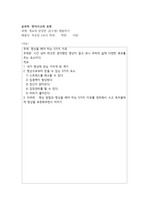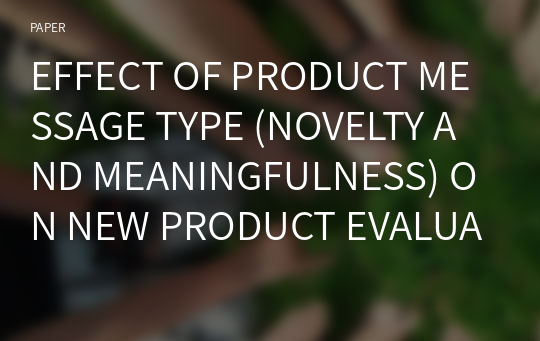EFFECT OF PRODUCT MESSAGE TYPE (NOVELTY AND MEANINGFULNESS) ON NEW PRODUCT EVALUATION WITH SPENDTHRIFT AND TIGHTWAD CONSUMERS
* 본 문서는 배포용으로 복사 및 편집이 불가합니다.
서지정보
ㆍ발행기관 : 글로벌지식마케팅경영학회(GFMC)
ㆍ수록지정보 : Global Marketing Conference
ㆍ저자명 : Taehyun Suh, Byung Kyu Kim, Subin Im
ㆍ저자명 : Taehyun Suh, Byung Kyu Kim, Subin Im
영어 초록
Effect of product message type (novelty and meaningfulness) on new product evaluation with spendthrift and tightwad consumersNew product development is one of key strategies that firms can use for survival and growth alike. Well-developed new products can generally provide much needed values for consumers, which in turn provide reasons and bases for firm’s growth and sustainable competitive advantages. Given this importance of new product development and launch, the understanding of what factors influence consumer’s new product purchase behavior is extremely critical for firms' success and just as important as the new product development itself. Previous research shows that many factors - such as perceived risk of new products (Ross 1975; Stone and Gronhaug 1993), consumer innovativeness as a personality (Midgley and Dowling, 1978; Steenkamp et al., 1999), and type of new products, e.g., discontinuous new product (Veryzer 1998) - influence the evaluation of new products. The current study contends that firm’s communication efforts for new products, in particular, the contents and types of message for new products, are as important as any other factors (often, even more critical than others). A consumer’s awareness of new product in the form of actual product launch or preannouncement of new product (Eliashberg and Robertson 1988) is important. Then, a naturally rising questions will be: (1) how should firm develop the contents of messages to consumers to spread the words? (2) who should be the target audience? In other words, depending on consumers and their individual differences, the message development for new product should be accordingly changed or modified to maximally generate consumer’s purchase behaviors. The goal of the message content is how to frame new products so that consumers seek to purchase the products. Two main approaches to frame advantages, strengths, or unique selling propositions of a new product would be (1) novelty and (2) meaningfulness (Im and Workman 2004). However, the framing message should be different depending on consumer’s individual differences. Given the complexity of modern consumers, firms need to understand not only the effect of situational factors such as product involvement (De Wulf, Odekerken-Schröder and Iacobucci, 2001), but also the influence of consumer’s different orientations in personality such as need of cognition (Cacioppo and Petty 1982) and need for uniqueness (Tian, Bearden, and Hunter 2001). Formally, in this study, not only message type, but also spending orientation of individual consumers will be explicitly examined to identify possible interactions effects on the new product purchase. In sum, the purpose of the current study is to examine the effect of message types and consumer’s spending orientation on the new product purchase decision. Specifically, the current study aims to suggest a significant interaction effect of message types of new product introduction (novelty or meaningfulness) as well as the format in which information is provided and individual consumers with opposite spending orientations.
Theoretical background
The development of the spendthrift-tightwad scale was created by Rick, Cryder, and Loewenstein (2008). In their scale, the authors define tightwads as individuals that have difficulty spending money whereas spendthrifts are individuals who have difficulty controlling their spending. Tightwads and spendthrifts do differ in levels of self-regulation (Tangney et al 2004). Tightwads are unable to free themselves from self-control even though their situation would become more favorable by spending money and spendthrifts have issues with exerting self-control even though it is in their best interest to limit their spending. Based on Rick et al (2008), spendthrifts are three times more likely than tightwads to carry debt as well as more amount of debt. Spendthrifts carry more debt and save less than tightwads. Spendthrifts are significantly more likely than tightwads to carry credit card debt at each income level. With respect to consumption purchase, spendthrifts are nine percent more likely than tightwads to buy a utilitarian massage and 26 percent more likely to buy the hedonic massage Rick et al (2008). Tightwads are significantly less likely to buy a massage in general. In sum, there will be a clear distinction between spendthrifts and tightwads in terms of utilitarian and hedonic purpose of consumptions. Thus we predict that,
H1: Spendthrifts are more likely to have a higher purchase intention score than tightwads
Meaningfulness and novelty are the two dimensions of new product creativity(Amabile 1983). Novelty is defined as the degree to which a new product is perceived as new and uniquely different to competitors, while meaningfulness is defined as the extent to which a new product is perceived as appropriate and useful. Consumers value novelty or meaningfulness depending on their level of product involvement and knowledge Rubera, Ordanini, and Mazursky (2010). However, products must have a wow or coolness factor to be accepted. Consumers do not appreciate a new product's creativity for its own sake but try to relate a product's meaningfulness and novelty to its utilitarian and hedonic value respectively(Im, Bhat, and Lee 2015). Therefore, we expect that
H2 (a): Spendthrifts have higher intentions to purchase a product if presented as a message with a novelty message than meaningful message.
H2 (b): Tightwads have higher intentions to purchase a product if presented as a message with meaningfulness than novelty.
Study design
The purpose of study is to see whether or not the manipulation of the message type describing a new product will lead to a higher purchasing intention. Framing the message with novelty shows that the product is new and unique, while framing the message with meaningfulness emphasizes a product's usefulness and ability to fulfill needs. We predict that the message type significantly influences the intentions a new product changes based on their tendencies of money use. The pretest is designed to check to see if the perceived value from both meaningfulness and novelty framing are be similar as well as the strength of attributes. Participants had been randomly assigned to one of two groups: a flyer with a meaningful message, a flyer with a novelty message. Participants were asked on a single item (7-point scale) of how much value the new product provides them. A second question asked the participants to rate on a 7 point scale asking how strong or convincing the message was given the provided attributes. A total 158 undergraduate students from a Midwestern land-grant university participated in this experiment, all provided with extra credits for class. Participants were randomly assigned to a group based on a 2 (Message type: Meaningfulness vs. Novelty) x 2 (individual difference: tightwad vs. spendthrift) x 2 (advertisement only vs. advertisement + customer review) between-subjects experiment. The dependent variables are attitude toward new product and purchase intentions. Participants were classified either as spendthrifts or tightwads. The spendthrift-tightwad scale provided by Rick, Cryder, and Loewenstein in (2008) came out to be reliable with a Cronbach alpha of .75 as stated in their development and validation section. With this reliability check, it will be safe to use their scale to differentiate participants as either spendthrifts or tightwads. This scale is used to measure an important individual trait of spending behavior which we believe is to interact with the message type. We also tested the effect of message vehicle (either advertisement or customer’s review), given the importance of source credibility. In the meaningfulness message type, participants are provided an advertisement flyer about a new product. There are six attributes about a new product (3 meaningful attributes and 3 novel attributes) and a message in the bottom half of the flyer describing the how this product will satisfy the customer's needs, useful, and or life changing. In the novelty message type, participants receive a similar flyer with the same product attributes as in the meaningfulness condition. The difference is in the message provided in the bottom half of the flyer. The message for novelty include phrases that indicate how new, unique, or revolutionary the product is. After the participants look over the flyer, they were asked if they would buy this new product. Then participants answered a follow-up question for the manipulation check. Participants in their respective message types were asked if how meaningful they think the product is they if they are in the meaningful condition and how novel they think they product is if they are within the novelty condition. For the customer review condition, a similar manipulation was used and the difference is that participants read customer reviews (emphasizing either meaningfulness or novelty of new product)
Measures
Advertisement novelty and meaningfulness are composite scales from six items respectively, with Cronbach alpha of 0.874 and 0.923. Product attitude are measured using four items (outstanding quality, reliable, consistent, and dependable) (Cronbach alpha = 0.919). Purchase intention measure is based on two items (how likely, how probable to purchase this product) using 7-point scales (Cronbach alpha = 0.827).Individual difference of spendthrift and tightwad measure is adopted from Rick, Cryder, and Loewenstein (2007). They used four items and simply summed scale responses (range from 4 to 26), and then divide respondents into three equally sized groups of sums (tightwad, unconflicted, and spendthrift). In our analysis, we followed the same approach, and used two groups (tightwad and spendthrift). The reliability (Cronbach alpha) was 0.756. However, for the manipulation check neither the novelty nor meaningfulness variable was significant. In the novelty condition, the participants did not experience a higher level of novelty in the message (t=.46, p=.65) while in the meaningfulness condition, participants did not experience a more meaningful focused message (t=-.485, p=.63). We must redesign the stimuli so that survey participants are properly manipulated to their allotted conditions.
Initial results
Attitude and purchase intention were higher for the advertisement plus customer review condition, compared to only advertisement groups. Also, there is a significant interaction effect among the message type and spending orientations influencing purchase intention. The spendthrifts to have higher intentions to purchase the product than tightwads similar to Rick, Cryder, and Loewenstein (2008) study with utilitarian and hedonic variables. There should be a significant effect of message type. The ANOVA results showed that overall model was significant (F =2.23, p=.048). ST-TW trait showed a significant effect on purchase decision (F= 7.454, p=.009). Thus, spendthrift respondents are more likely to purchase new products than tightwad ones, which is a consistent result to the existing literature.
Implications and conclusions
Message strategy for new product will be of critical criterion, because a convincing and creative advertising campaign will capture the attention of consumers. It will be important for firms to incorporate customer reviews in juxtaposition with the advertisement message, as it is much more likely for a consumer to purchase a product when a review is present based on the results above. Essentially, providing customer information becomes important, when you develop a message in advertisement that also provides a complimentary consumer review. However, depending on consumer’s characteristics regarding spendthrift-tightwad orientation, the choice of either advertising or specific promotion, encouraging encourage consumer to purchase. In sum, the results strongly suggest that using both advertisement and customer review information provision would increase purchase decision, but complementary focus of information provision will be the most effective way to deliver message to audience. In addition, individual different in spending orientation can be an important moderator, which suggest a series of further research.
참고 자료
없음"Global Marketing Conference"의 다른 논문
 THE ROLES OF GREEN PACKAGING IN UGLY FOOD PURCHASE INTE..22페이지
THE ROLES OF GREEN PACKAGING IN UGLY FOOD PURCHASE INTE..22페이지 THE IMPACT OF INDUCED AWE ON ETHICAL TOURIST BEHAVIORS5페이지
THE IMPACT OF INDUCED AWE ON ETHICAL TOURIST BEHAVIORS5페이지 A BIBLIOMETRIC ANALYSIS OF SPIRITUAL TOURISM RESEARCH15페이지
A BIBLIOMETRIC ANALYSIS OF SPIRITUAL TOURISM RESEARCH15페이지 SOCIAL NETWORK ANALYSIS AND RESPONSE TIME TESTING: CONS..11페이지
SOCIAL NETWORK ANALYSIS AND RESPONSE TIME TESTING: CONS..11페이지 THE EFFECTS OF PARA-SOCIAL INTERACTION ON ONLINE CELEBR..3페이지
THE EFFECTS OF PARA-SOCIAL INTERACTION ON ONLINE CELEBR..3페이지 THE INFLUENCE OF OPINION LEADERS ON DAILY DEALS USER’S ..3페이지
THE INFLUENCE OF OPINION LEADERS ON DAILY DEALS USER’S ..3페이지 HOW IMMERSIVE RETAILING AFFECTS CONSUMERS’ URGE TO BUY:..6페이지
HOW IMMERSIVE RETAILING AFFECTS CONSUMERS’ URGE TO BUY:..6페이지 KEY TO SUPERSTARDOM IN A GLOBALISED MARKET: THE ROLE OF..6페이지
KEY TO SUPERSTARDOM IN A GLOBALISED MARKET: THE ROLE OF..6페이지 A POST-PANDEMIC LOOK AT TOURISTS’ PERCEIVED COOLNESS OF..4페이지
A POST-PANDEMIC LOOK AT TOURISTS’ PERCEIVED COOLNESS OF..4페이지 EXTRACTING OFFLINE RETAIL SHOPPING PATTERNS: OLLABORATI..5페이지
EXTRACTING OFFLINE RETAIL SHOPPING PATTERNS: OLLABORATI..5페이지





















